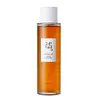What's inside
What's inside
 Key Ingredients
Key Ingredients

 Benefits
Benefits

 Concerns
Concerns

No concerns
 Ingredients Side-by-side
Ingredients Side-by-side

Panax Ginseng Root Water
MaskingButylene Glycol
HumectantGlycerin
HumectantPropanediol
SolventNiacinamide
Smoothing1,2-Hexanediol
Skin ConditioningWater
Skin ConditioningHydroxyacetophenone
AntioxidantGlyceryl Glucoside
HumectantXanthan Gum
EmulsifyingPanthenol
Skin ConditioningDipotassium Glycyrrhizate
HumectantAllantoin
Skin ConditioningAdenosine
Skin ConditioningPanax Ginseng Callus Culture Extract
Skin ConditioningTheobroma Cacao Extract
Skin ConditioningDextrin
AbsorbentGlucose
HumectantPanax Ginseng Root Extract
EmollientPanax Ginseng Berry Extract
Skin ConditioningLactobacillus
Skin ConditioningSodium Hyaluronate
HumectantEthylhexylglycerin
Skin ConditioningDisodium EDTA
Panax Ginseng Root Water, Butylene Glycol, Glycerin, Propanediol, Niacinamide, 1,2-Hexanediol, Water, Hydroxyacetophenone, Glyceryl Glucoside, Xanthan Gum, Panthenol, Dipotassium Glycyrrhizate, Allantoin, Adenosine, Panax Ginseng Callus Culture Extract, Theobroma Cacao Extract, Dextrin, Glucose, Panax Ginseng Root Extract, Panax Ginseng Berry Extract, Lactobacillus, Sodium Hyaluronate, Ethylhexylglycerin, Disodium EDTA
Water
Skin ConditioningLactobacillus Ferment
Skin ConditioningPropanediol
SolventAloe Barbadensis Leaf Extract
EmollientPersea Gratissima Oil
Skin ConditioningCucumis Sativus Fruit Water
Skin ConditioningCamellia Sinensis Leaf Extract
AntimicrobialRaphanus Sativus Sprout Extract
AntioxidantLens Culinaris Seed Extract
AntimicrobialVaccinium Macrocarpon Fruit Extract
AstringentMadecassoside
AntioxidantTocopheryl Acetate
AntioxidantAscorbyl Glucoside
AntioxidantSodium Anisate
AntimicrobialSodium Levulinate
Skin ConditioningSodium Hyaluronate
HumectantHydrogenated Vegetable Oil
EmollientSodium Gluconate
Skin ConditioningSqualane
EmollientPhospholipids
Skin ConditioningGlycerin
HumectantRosa Centifolia Flower Extract
AstringentPolyglyceryl-10 Laurate
Skin ConditioningCitric Acid
BufferingPentylene Glycol
Skin ConditioningArginine
MaskingWater, Lactobacillus Ferment, Propanediol, Aloe Barbadensis Leaf Extract, Persea Gratissima Oil, Cucumis Sativus Fruit Water, Camellia Sinensis Leaf Extract, Raphanus Sativus Sprout Extract, Lens Culinaris Seed Extract, Vaccinium Macrocarpon Fruit Extract, Madecassoside, Tocopheryl Acetate, Ascorbyl Glucoside, Sodium Anisate, Sodium Levulinate, Sodium Hyaluronate, Hydrogenated Vegetable Oil, Sodium Gluconate, Squalane, Phospholipids, Glycerin, Rosa Centifolia Flower Extract, Polyglyceryl-10 Laurate, Citric Acid, Pentylene Glycol, Arginine
 Reviews
Reviews

Ingredients Explained
These ingredients are found in both products.
Ingredients higher up in an ingredient list are typically present in a larger amount.
Glycerin is already naturally found in your skin. It helps moisturize and protect your skin.
A study from 2016 found glycerin to be more effective as a humectant than AHAs and hyaluronic acid.
As a humectant, it helps the skin stay hydrated by pulling moisture to your skin. The low molecular weight of glycerin allows it to pull moisture into the deeper layers of your skin.
Hydrated skin improves your skin barrier; Your skin barrier helps protect against irritants and bacteria.
Glycerin has also been found to have antimicrobial and antiviral properties. Due to these properties, glycerin is often used in wound and burn treatments.
In cosmetics, glycerin is usually derived from plants such as soybean or palm. However, it can also be sourced from animals, such as tallow or animal fat.
This ingredient is organic, colorless, odorless, and non-toxic.
Glycerin is the name for this ingredient in American English. British English uses Glycerol/Glycerine.
Learn more about GlycerinPropanediol is an all-star ingredient. It softens, hydrates, and smooths the skin.
It’s often used to:
Propanediol is not likely to cause sensitivity and considered safe to use. It is derived from corn or petroleum with a clear color and no scent.
Learn more about PropanediolSodium Hyaluronate is hyaluronic acid's salt form. It is commonly derived from the sodium salt of hyaluronic acid.
Like hyaluronic acid, it is great at holding water and acts as a humectant. This makes it a great skin hydrating ingredient.
Sodium Hyaluronate is naturally occurring in our bodies and is mostly found in eye fluid and joints.
These are some other common types of Hyaluronic Acid:
Learn more about Sodium HyaluronateWater. It's the most common cosmetic ingredient of all. You'll usually see it at the top of ingredient lists, meaning that it makes up the largest part of the product.
So why is it so popular? Water most often acts as a solvent - this means that it helps dissolve other ingredients into the formulation.
You'll also recognize water as that liquid we all need to stay alive. If you see this, drink a glass of water. Stay hydrated!
Learn more about Water